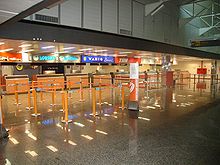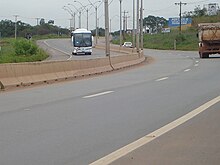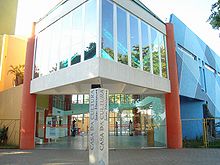Porto Velho
Porto Velho | |
|---|---|
Municipality | |
| The Municipality of Porto Velho | |
 Collage | |
 Location of Porto Velho in the State of Rondônia | |
| Country | |
| Region | North |
| State | |
| Government | |
| • Mayor | Roberto Sobrinho (PT) |
| Area | |
| • Total | 34.082 km2 (13.159 sq mi) |
| Population (2010)[1] | |
| • Total | 426,558 |
| Time zone | UTC-4 (UTC-4) |
| Postal Code | 76800-000 |
| Website | Porto Velho, Rondônia |
Porto Velho (Portuguese pronunciation: [ˈpoʁtu ˈvɛʎu], Old Port) is the capital of the Brazilian state of Rondônia, in the upper Amazon River basin. The population is estimated to be 426,558 people (IBGE/2010). Located at the border of Rondônia and the state of Amazonas, the town is an important trade center of cassiterite, the mining of which represents the most important economic activity in the region, and a transportation and communication center. It is located on the eastern shore of the Madeira River, one of the main tributaries of the Amazon River. And is also Rondônia's biggest city.
The municipality occupies most of the border between Amazonas and Rondônia, and is simultaneously the westernmost and northernmost city in the state.
History
Officially founded on October 2, 1914, Porto Velho was started by pioneers around 1907, during the construction of the Madeira-Mamoré Railroad. After the railroad was completed, the local population was about one thousand inhabitants; its buildings were chiefly the railway's installations and the wooden houses of the Caribbean workers - hence the name of the town's largest district by then, "Barbados Town", nowadays called the "Alto do Bode".
During the first sixty years, the city's development was directly connected to the railway's activities. The town prospered during the rubber boom, but then when low-cost Malaysian rubber made rubber from the Amazon uncompetitive, the region's economy ground to a halt. Cities like Santo Antônio do Madeira, which had a tram line and a weekly newspaper by the time of Porto Velho's foundation, are nothing but ruins nowadays.
Porto Velho's survival is associated with the better conditions of the area where it was built, its easy access by the river and its harbor: these were all considerations in the choice of Porto Velho as the capital of the newly-formed Federal Territory of Guaporé, in 1943. Only with the beginning of World War II there was another cycle of progress in the region. When the Allied forces lost control over the Malaysian rubber, Amazon's was needed due to the war effort. This produced what is known in Brazil as the "second rubber boom". But when the war ended, the region's economy once again came to a halt.
Porto Velho's modern history begins with the discovery of cassiterite around the city, and of gold on the Madeira River, by the end of the 1950s. Also, the government's decision to allow large cattle farms in the territory began a trend of migration into the city. Almost one million people moved to Rondônia, and Porto Velho's population increased to three hundred thousand. This intense migration caused much trouble for the city. For example, the suburban boroughs are nothing but shanty towns, among many other problems.[vague]
Geography

Climate
An equatorial climate is a type of tropical climate in which there is no dry season – all months have mean precipitation values of at least 60 mm. It is usually found at latitudes within five degrees of the equator – which are dominated by the Intertropical Convergence Zone. The equatorial climate is denoted Af in the Köppen climate classification. Tropical rainforest is the natural vegetation in equatorial regions.
Vegetation
The Amazon represents over half of the planet's remaining rainforests and comprises the largest and most species-rich tract of tropical rainforest in the world. Wet tropical forests are the most species-rich biome, and tropical forests in the Americas are consistently more species rich than the wet forests in Africa and Asia.[2] As the largest tract of tropical rainforest in the Americas, the Amazonian rainforests have unparalleled biodiversity.
More than 1/3 of all species in the world live in the Amazon Rainforest.[3]
Economy
The GDP for the city was R$ 3,656,512,000 (2005).[4]
The per capita income for the city was R$ 9,779 (2005).[5]
Cityscape
Infrastructure


International Airport
Porto Velho International Airport, located seven kilometers from the city, has as its main access at the Av. Governador Jorge Teixeira de Oliveira, with two lanes. Buses from downtown run to the airport every hour, and there is a fleet of taxis serving only the airport. The airport is served by 98 scheduled flights weekly, most going to other large Brazilian cities. The presence of Porto Velho Air Force Base ensures considerable movement of military aircraft. The local people refer to Porto Velho International as Belmont Airport because it is located in this district. It became an international airport in 2002.
Highways
- BR-174;
- BR-317;
- BR-319;
- BR-364;
- BR-421;
- BR-425;
- BR-429;
- RO-010;
- RO-101;
- RO-490.
Education

Portuguese is the official national language, and thus the primary language taught in schools. But English and Spanish are part of the official high school curriculum.
Most Known Colleges
- Universidade Federal de Rondônia (Unir);
- Instituto Luterano de Ensino Superior de Porto Velho (Iles-Ulbra);
- Faculdade Interamericana de Porto Velho (Uniron);
- Faculdade de Ciências Administrativas e de Tecnologia (Fatec-RO);
- Faculdade de Ciências Humanas, Exatas e Letras de Rondônia (Faro);
- Faculdade da Amazônia (Iesa);
- Faculdade de Porto Velho/ Fundação Getúlio Vargas (FIP/FGV);
- Faculdades Integradas Maria Coelho Aguiar (FIMCA);
- Faculdade São Lucas;
Most Known Schools
- Classe A;
- Colégio Objetivo;
- Escola Estadual de Ensino Fundamental e Médio João Bento da Costa;
- Colégio Tiradentes da Polícia Militar;
- Centro de Ensino Mineiro;
- Proensino;
- Instituto Laura Vicuña;
- Instituto Estadual de Educação Carmela Dutra;
Culture

Expovel
Agricultural event in Porto Velho.
Museum
Madeira-Mamoré Railway Museum (pt: Museu da Estrada de Ferro Madeira Mamoré)
Theatre
Teatro Municipal, in Joaquim Nabuco Avenue (Downtown) and Teatro Uirassu Rodrigues, in José Bonifácio street.
References
- ^ [1] - IBGE/2008
- ^ Turner, I.M. 2001. The ecology of trees in the tropical rain forest. Cambridge University Press, Cambridge. ISBN 0-521-80183-4
- ^ Amazon Rainforest, Amazon Plants, Amazon River Animals
- ^ GDP (PDF) (in Portuguese). Porto Velho, Brazil: IBGE. 2005. ISBN 85-240-3919-1. Retrieved 2007-07-18.
- ^ per capita income (PDF) (in Portuguese). Porto Velho, Brazil: IBGE. 2005. ISBN 85-240-3919-1. Retrieved 2007-07-18.



